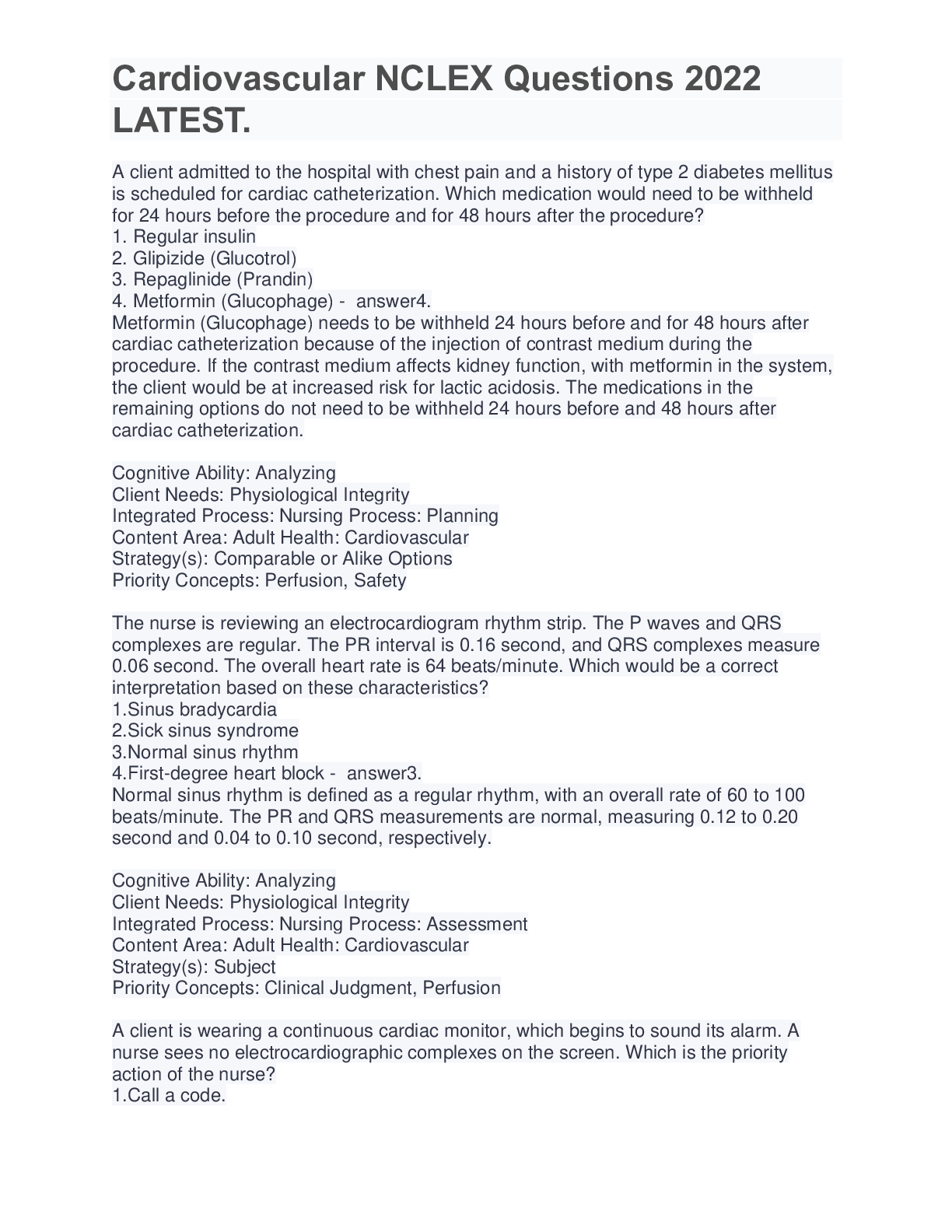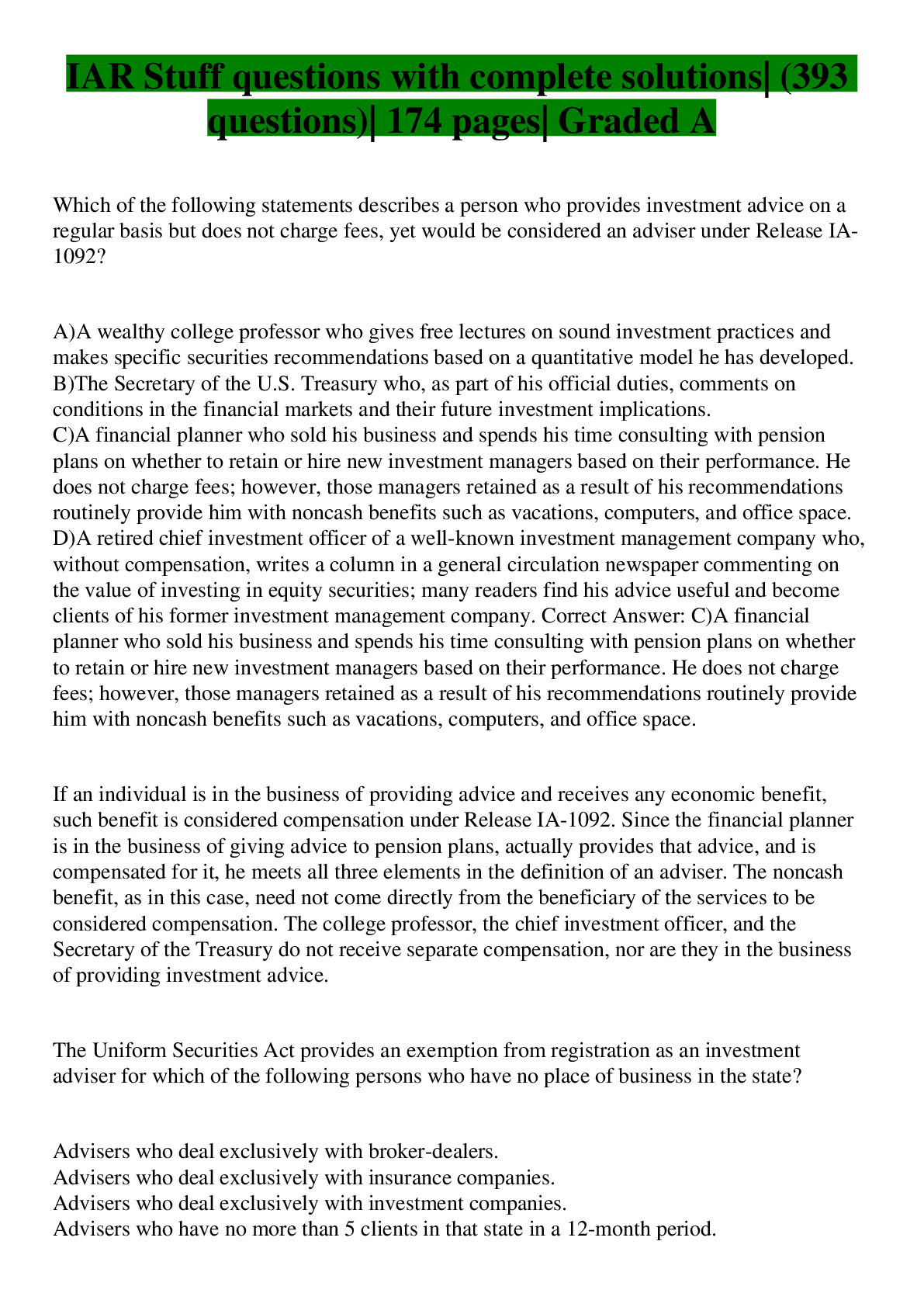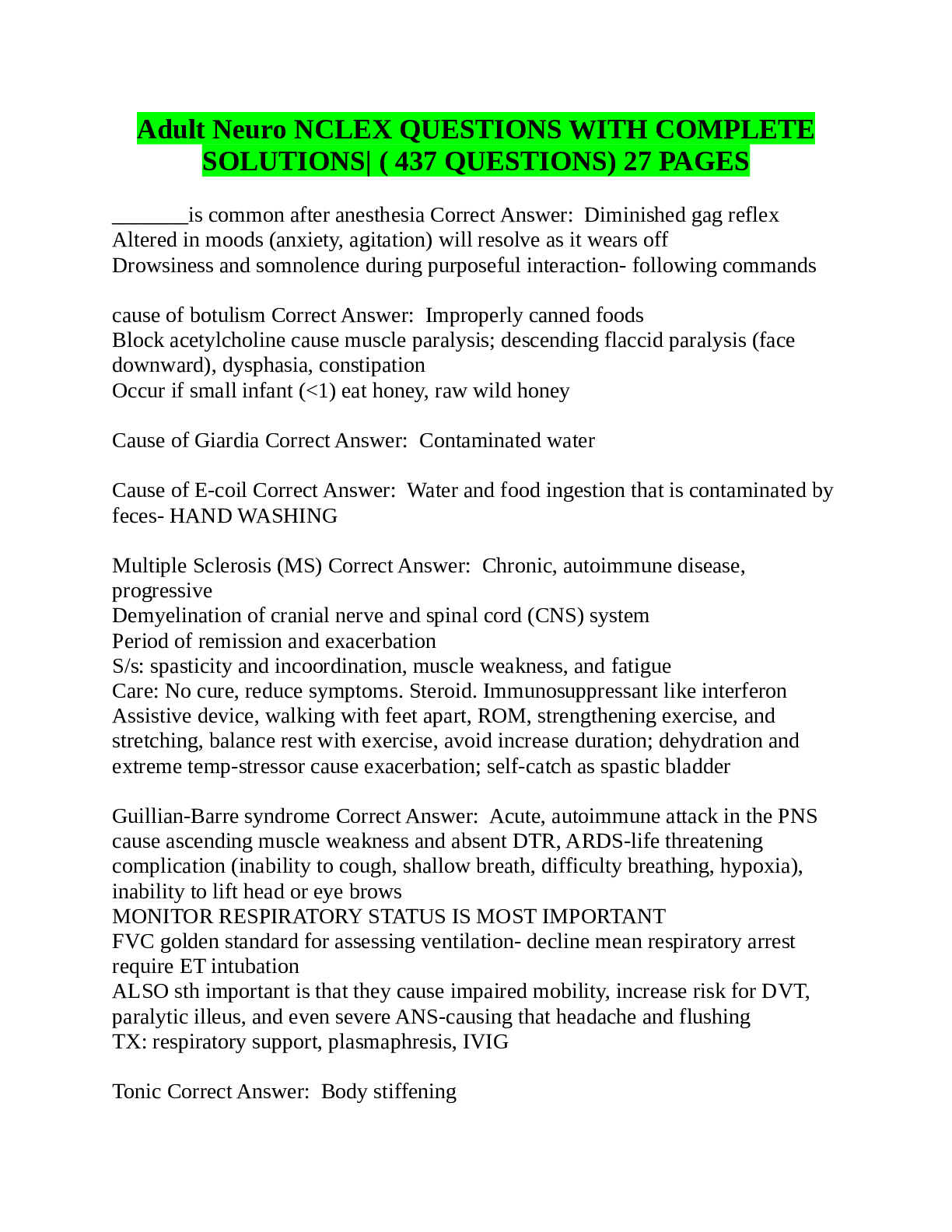Health Care > EXAM > Adult Neuro NCLEX QUESTIONS WITH COMPLETE SOLUTIONS| ( 437 QUESTIONS) 27 PAGES (All)
Adult Neuro NCLEX QUESTIONS WITH COMPLETE SOLUTIONS| ( 437 QUESTIONS) 27 PAGES
Document Content and Description Below
_______is common after anesthesia Correct Answer: Diminished gag reflex Altered in moods (anxiety, agitation) will resolve as it wears off Drowsiness and somnolence during purposeful interaction- f... ollowing commands cause of botulism Correct Answer: Improperly canned foods Block acetylcholine cause muscle paralysis; descending flaccid paralysis (face downward), dysphasia, constipation Occur if small infant (<1) eat honey, raw wild honey Cause of Giardia Correct Answer: Contaminated water Cause of E-coil Correct Answer: Water and food ingestion that is contaminated by feces- HAND WASHING Multiple Sclerosis (MS) Correct Answer: Chronic, autoimmune disease, progressive Demyelination of cranial nerve and spinal cord (CNS) system Period of remission and exacerbation S/s: spasticity and incoordination, muscle weakness, and fatigue Care: No cure, reduce symptoms. Steroid. Immunosuppressant like interferon Assistive device, walking with feet apart, ROM, strengthening exercise, and stretching, balance rest with exercise, avoid increase duration; dehydration and extreme temp-stressor cause exacerbation; self-catch as spastic bladder Guillian-Barre syndrome Correct Answer: Acute, autoimmune attack in the PNS cause ascending muscle weakness and absent DTR, ARDS-life threatening complication (inability to cough, shallow breath, difficulty breathing, hypoxia), inability to lift head or eye brows MONITOR RESPIRATORY STATUS IS MOST IMPORTANT FVC golden standard for assessing ventilation- decline mean respiratory arrest require ET intubation ALSO sth important is that they cause impaired mobility, increase risk for DVT, paralytic illeus, and even severe ANS-causing that headache and flushing TX: respiratory support, plasmaphresis, IVIG Tonic Correct Answer: Body stiffening Clonic Correct Answer: Muscle jerking Atomic Correct Answer: Loss of muscle tone Supraglottic swallow Correct Answer: Technique that allows them to have voluntary control over vocal cords to protect themselves from aspiration CN IX _______ decrease risk of Ad Correct Answer: Smoking cessation, avoid excessive alcohol intake, exercise reg, and participate in mental activities Frontal lobe Correct Answer: Related to knowledge thing Broca aphasia or expressive aphasia: inability to express words- after TIA or stroke Executive function and personality Behavioral change Temporal Correct Answer: Auditory and past experience Wernickle aphasia- receptive aphasia Report a _________________ is a priority for GCS even if it is only change by ___ Correct Answer: negative trends 1 Initial (means acute) phase of suspected stroke Correct Answer: CT scan, baseline neuro assessment, and prepare tpA Medulla oblongata Correct Answer: Rate and depth of respiration Parietal lobe Correct Answer: Sensory problems-touch Occipital lobe Correct Answer: Visual problems- coup-counter coup Straining or Valsalva maneuver Correct Answer: Holding breathing when bearing down Contraindicated for pt with increased ICP, head injury, stroke, pt with anything can increase abdominal and thoracic pressure- glaucoma, eye surgery, cirrhosis-portal HTN, abdominal surgery, heart disease like MI Spinal immobilization Correct Answer: NSAIDS Neurological examination Significant traumatic mechanism of injury Alertness-pt maybe disoriented Intoxication Distracting injury-sth else distract pt from spinal pain Spinal examination: tenderness over spine or neck pain on movement may be present Transferring stroke pt from bed to chair Correct Answer: Wear non-skid shoes-first step Bed and wheelchair brakes are locked Transfer belt Transfer pt toward the stronger side. If pt is weak on the left, ask the pt to pivot on the right Never bending at the waist Always keep the leg wide for stability Pivot on the foot distal to the chair What is the risk factors for stroke? WHAT is the most important one that you can change? Correct Answer: DM, high cholesterol, HTN, smoking, obesity And the biggest thing you can change is HTN-take med as precscribed Cerebellum has two functions Correct Answer: coordination of voluntary movement, and maintenance of balance and posture Test for cerebellum function Correct Answer: gait testing-watching normal gait then gait on heel-to-toe (tandem), on toes, and on heels Finger taping Correct Answer: each finger to the hand's thumb Rapid alternating movement Correct Answer: supination and pronation Finger to nose Correct Answer: pt touch HCP's finger and then touch their own nose Heel-to-shin Correct Answer: run each heel down each shin while in supine position Sensory test Correct Answer: ifentify the number 8 traced on the palm-fine touch (graphesthesia). Other tests like identifying object in the hand (stereognosis) and two point discrimination CN I-III Correct Answer: smells or vision (three O) CN IV Correct Answer: trochlea- eyes and motor CN V, VII, IX Correct Answer: trigeminal, facial, and glossopharyngeal- most commonly ask cranial nerves CN IX Correct Answer: glosso is tongue and pharyngeal is pharynx: assess gag reflex- freaking out about it because it concerns AIRWAY. Sensory posterior taste .Test: swallowing water CN VII Correct Answer: facial nerve-unilateral paralysis- bell's palsy or facial nerve palsy. S/s: decreased nasolabial folds, drooping mouth (asymmetrical). Nursing care: can't close their eyes- so we worry about corneal abrasion- keep it lubricate and close it for them or put a patch for them, don't let them dry out-same with the mouth- at risk for dental caries Cn V Correct Answer: trigeminal-temporal region, 3 branches, one go to eye, 1 cheek, 1 down the jawline. sensory-face, motor: chewing. So these patients are extremely sensitive to touch and temperature. So if a pt has a problem with this, extremely sensitive to touch and temperature (feel like a knife stabbing a patients). Tx: carbamazepine- side effect: SJS and agranulocytosis-sepsis risk-presentation: muscle cramps, hypokalemia, cold, pale peripheral edema, HF, UTI, sore throat,...) (clozapine can also cause agranulocytosis as well) Cn VI Correct Answer: abducens: motor, eyes Cn VIII Correct Answer: sensory, hearing, and balance CN X Correct Answer: Vagus sensory: throat; motor [Show More]
Last updated: 1 year ago
Preview 1 out of 32 pages
Instant download

Buy this document to get the full access instantly
Instant Download Access after purchase
Add to cartInstant download
Reviews( 0 )
Document information
Connected school, study & course
About the document
Uploaded On
Sep 23, 2022
Number of pages
32
Written in
Additional information
This document has been written for:
Uploaded
Sep 23, 2022
Downloads
0
Views
41


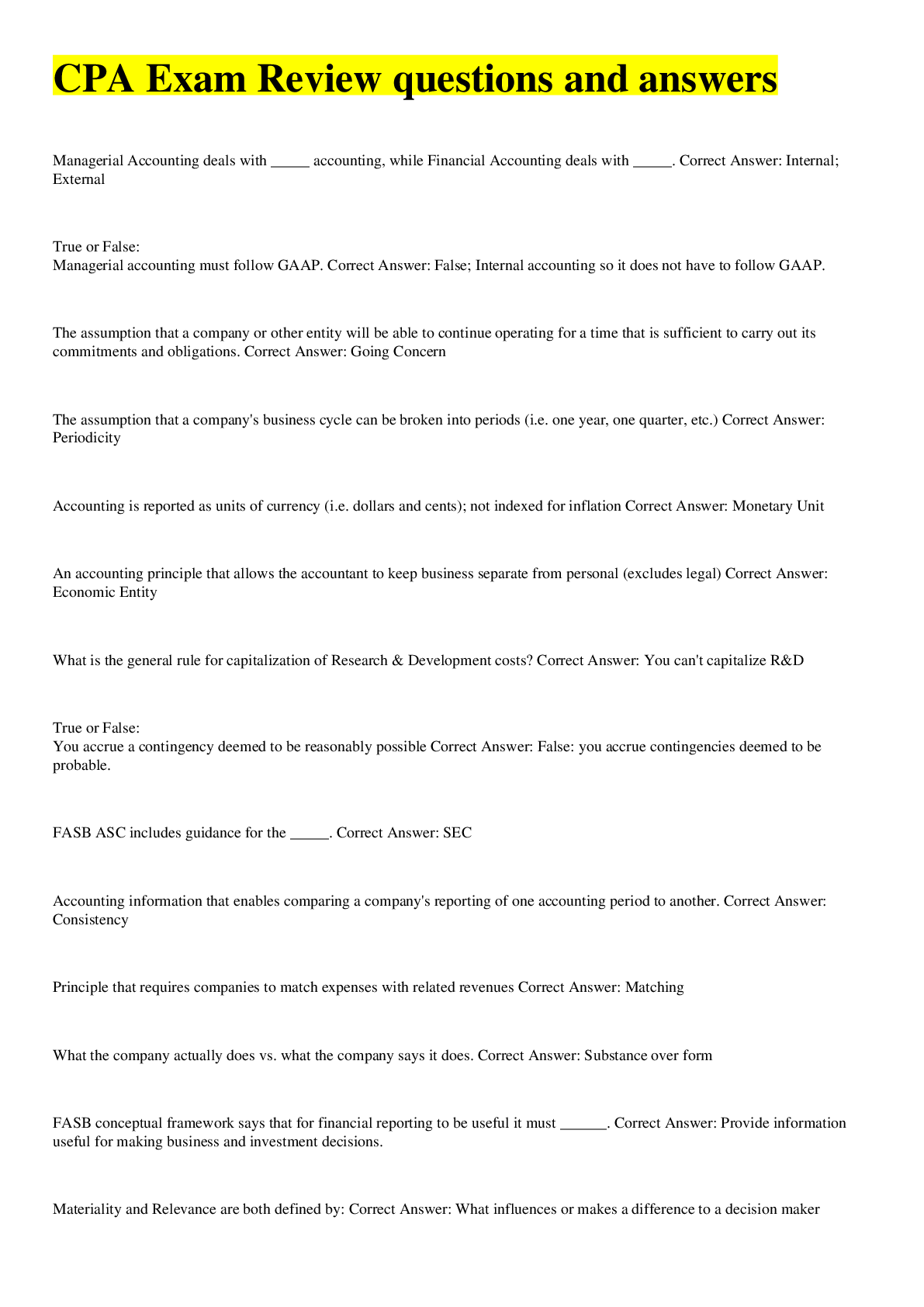
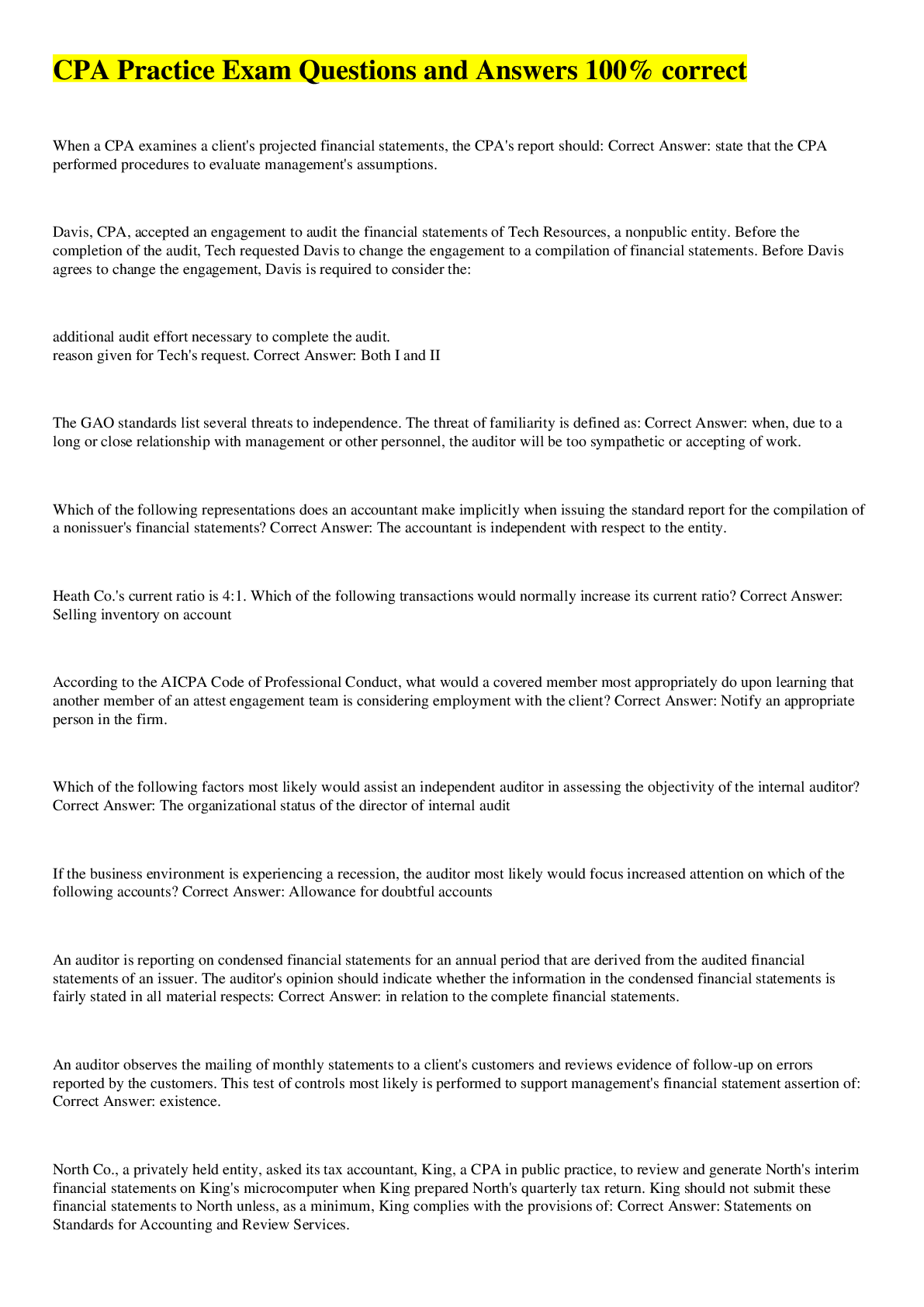
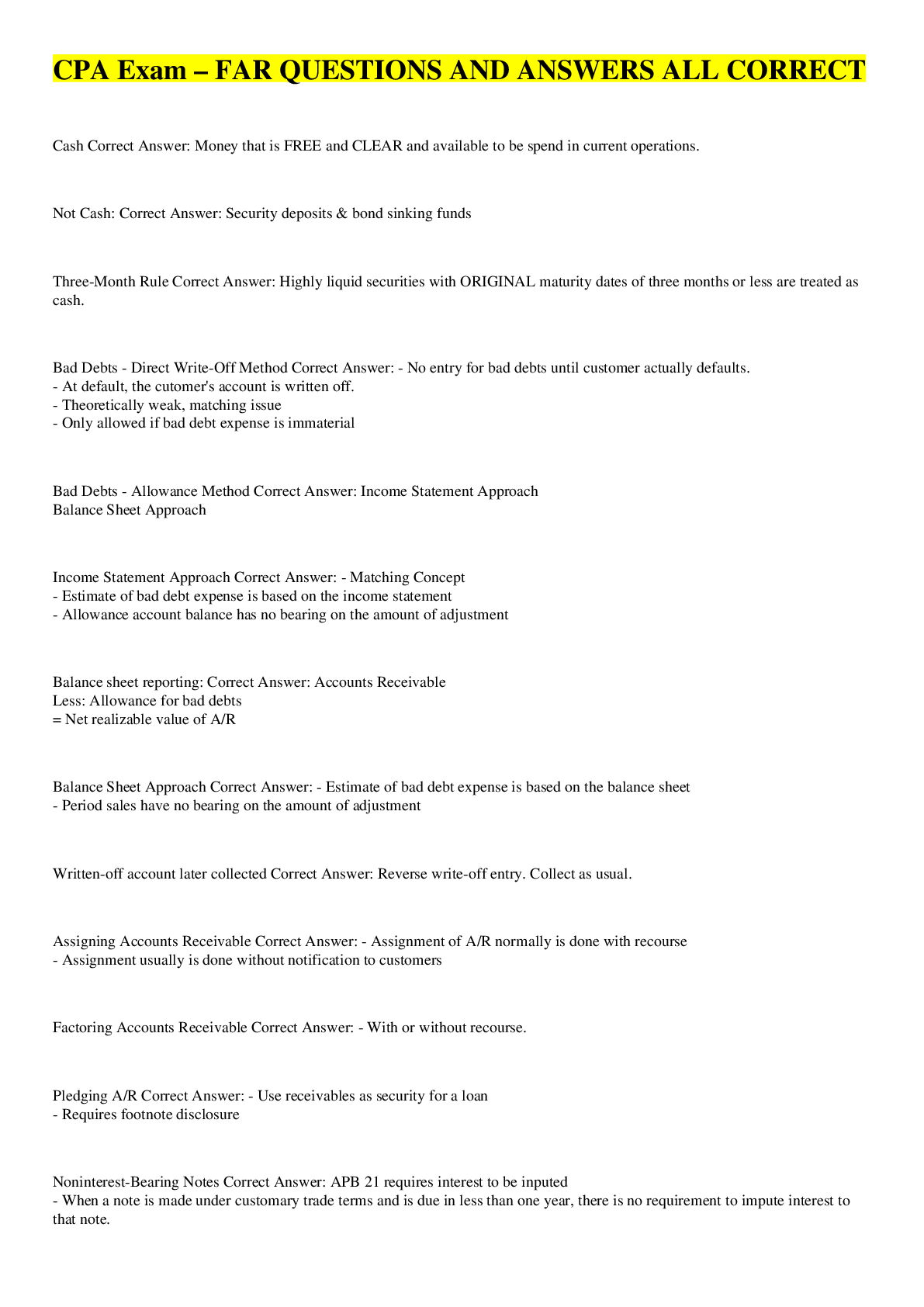
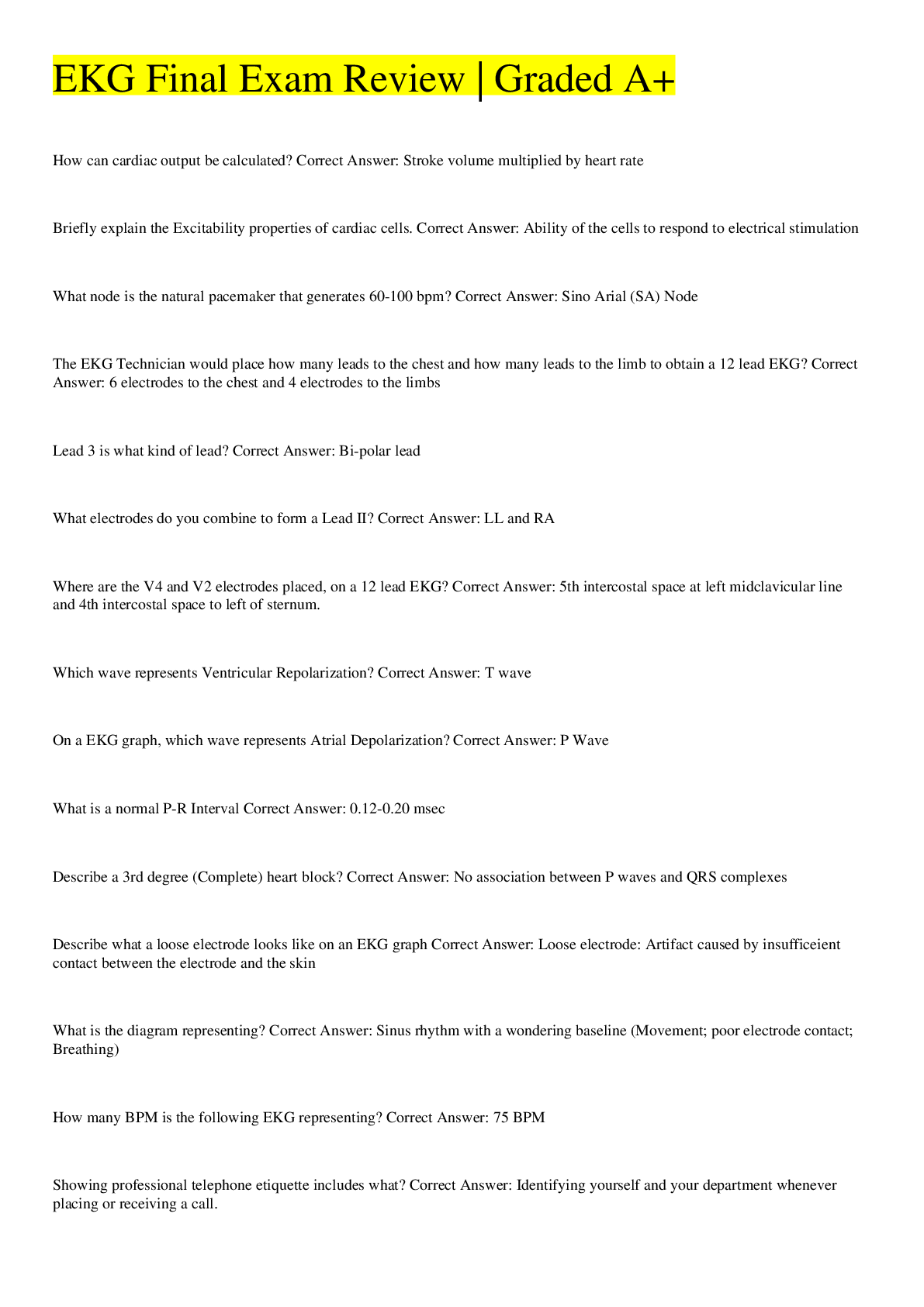

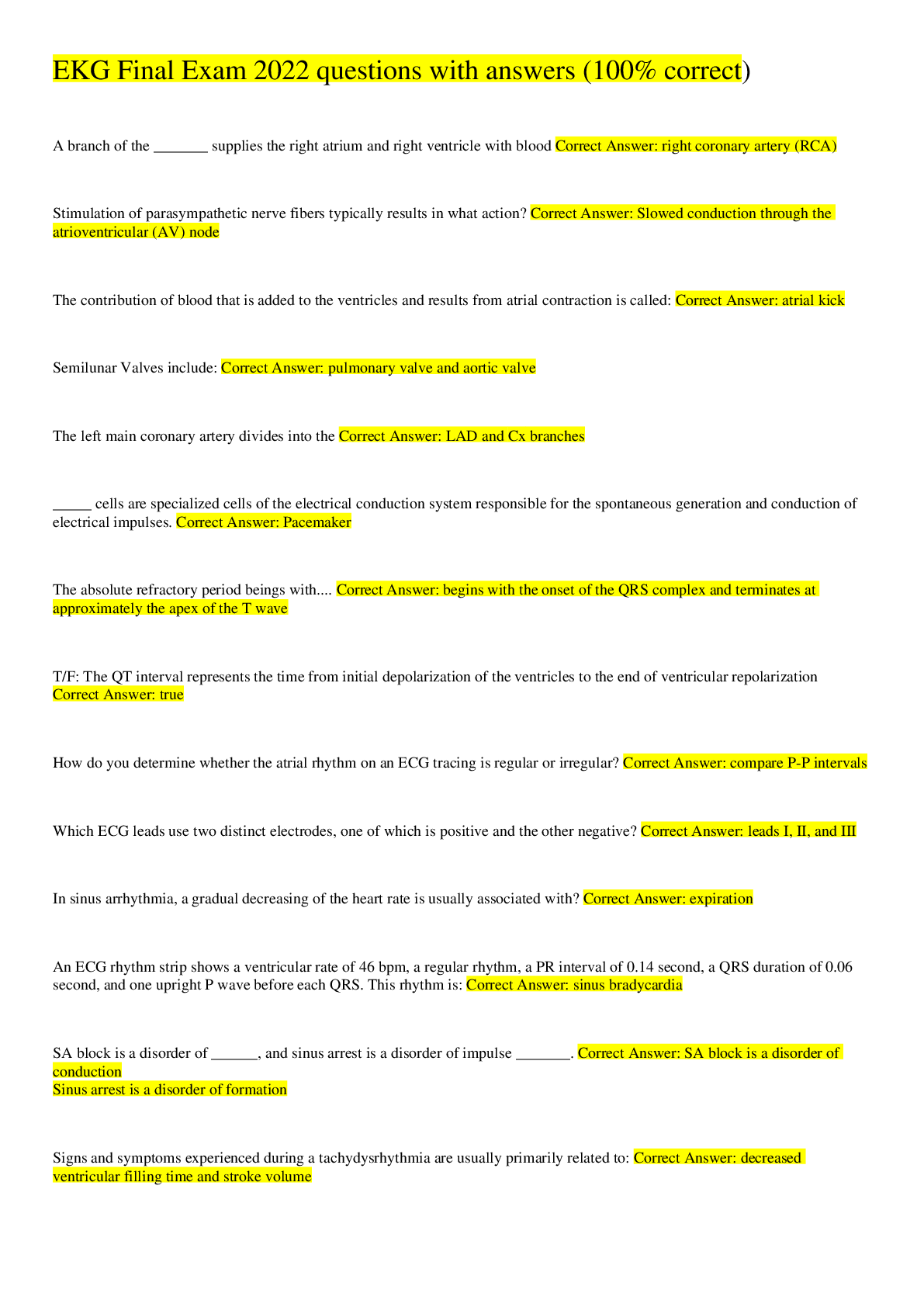
.png)
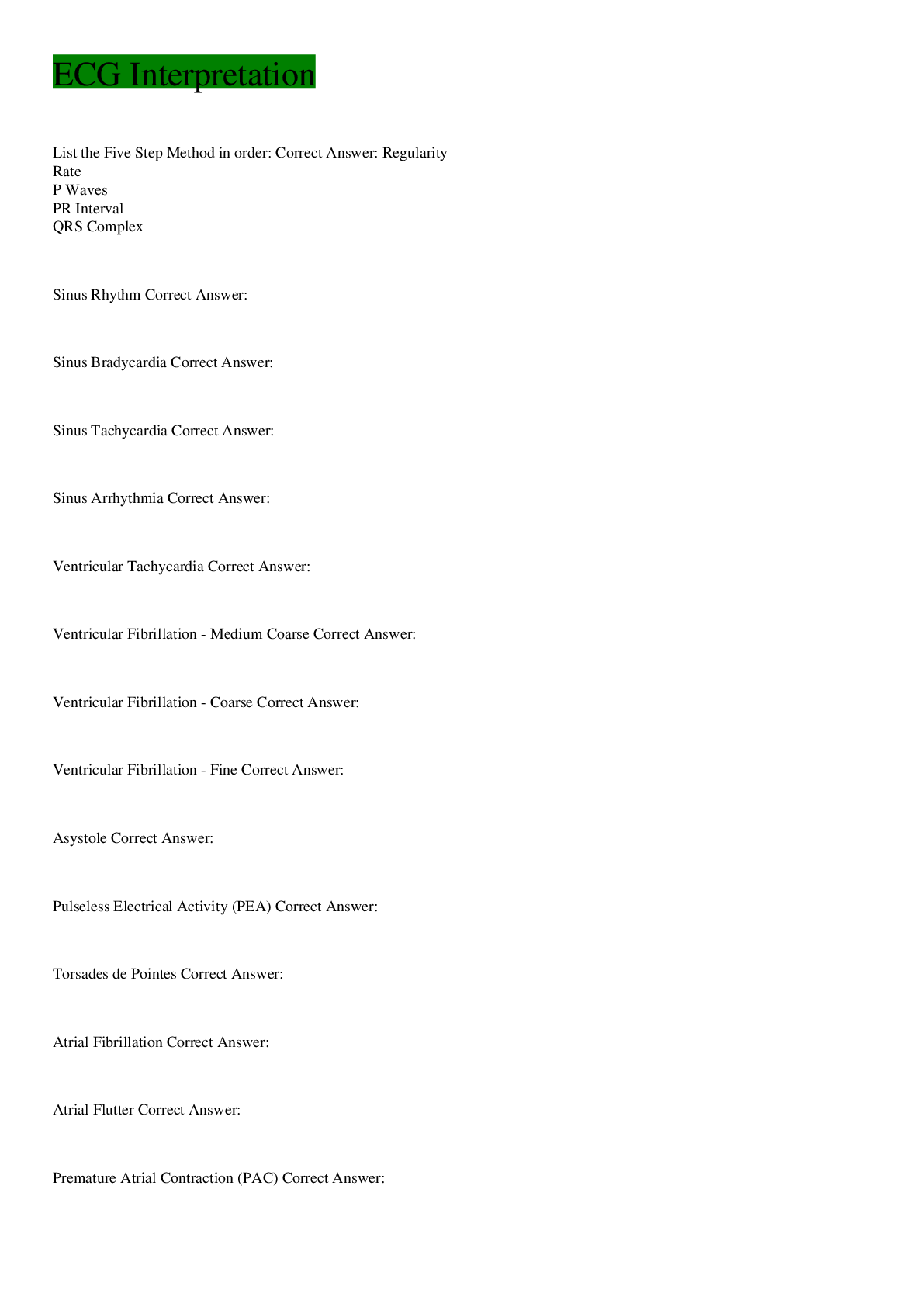




.png)
.png)
.png)
